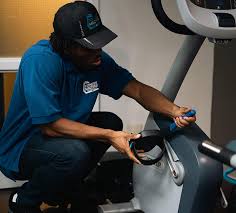In today’s health-conscious world, fitness equipment has become an essential part of both commercial gyms and home workout spaces. Whether it’s a treadmill, elliptical, stationary bike, or multi-gym machine, regular use can cause wear and tear, making fitness equipment repair a crucial service. This comprehensive article covers everything you need to know about fitness equipment repair — from common issues and DIY tips to when to call a professional.
🚨 Why Fitness Equipment Repair Matters
Properly functioning fitness equipment is not just about convenience—it’s also about safety and effectiveness. Ignoring minor issues can lead to bigger problems like breakdowns or accidents. Regular maintenance and timely repairs:
-
Extend the lifespan of machines
-
Ensure user safety
-
Save money on costly replacements
-
Maintain performance for optimal workouts
🔧 Common Fitness Equipment Problems
-
Treadmills
-
Slipping belt
-
Motor not running
-
Inaccurate speed or incline
-
Noisy operation
-
-
Ellipticals
-
Squeaky pedals or arms
-
Resistance malfunction
-
Console not turning on
-
-
Stationary Bikes
-
Pedal resistance issues
-
Loose or broken belts
-
Display malfunctions
-
-
Home Gyms
-
Cable fraying or snapping
-
Pulley issues
-
Weight stack misalignment
-
🛠️ DIY Fitness Equipment Repair Tips
While some problems require professional help, many minor issues can be fixed with simple tools and know-how:
-
Lubricate moving parts: Keeps machines running smoothly and quietly.
-
Tighten bolts and screws: Regularly inspect to prevent wobbly or unstable parts.
-
Check power connections: Loose plugs or dead batteries often cause electronic issues.
-
Clean your equipment: Dust and sweat can cause corrosion or clog moving parts.
⚠️ Always consult your user manual before attempting repairs to avoid voiding warranties or causing further damage.
👨🔧 When to Call a Professional Repair Service
Some issues are beyond the scope of a DIY fix. It’s best to call a certified fitness repair technician if you experience:
-
Electrical or console failures
-
Motor or resistance system malfunctions
-
Broken cables, belts, or pulleys
-
Unusual burning smells or smoke
Professional technicians come equipped with specialized tools, replacement parts, and the expertise to diagnose and repair a wide range of fitness equipment issues.
🔍 How to Choose the Best Fitness Equipment Repair Service
When searching for a fitness repair technician near you, look for these key qualities:
-
✅ Certified and experienced technicians
-
✅ Positive reviews and testimonials
-
✅ Fast response time and availability
-
✅ Transparent pricing
-
✅ Warranty on parts and labor
Pro Tip: Ask if they service your specific brand or type of equipment before booking.
🔄 Preventive Maintenance: The Best Repair is Prevention
Regular maintenance can reduce the need for repairs. Consider scheduling a professional check-up every 6–12 months, especially for high-use machines in gyms.
Basic maintenance checklist:
-
Weekly: Wipe down equipment, inspect for visible damage.
-
Monthly: Lubricate belts, inspect bolts and screws.
-
Quarterly: Calibrate electronics, check tension and alignment.
-
Yearly: Full inspection and tune-up by a technician.
🏁 Final Thoughts
Fitness equipment repair is a smart investment in your health, safety, and workout performance. Whether you’re managing a commercial gym or just want your home treadmill to work like new, knowing how to identify issues, perform basic fixes, and call in the pros when needed can save time, money, and frustration.
